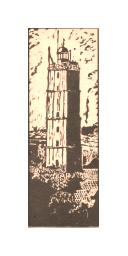
Hinne de Jong
A Chronicle
translated/arranged by his son, Sense de Jong
Hinne leaves Terschelling
- 1: Introduction
- 2: Captain Pieter
- 3: Childhood years
- 4: Shipwreck
- 5: Teenager
- 6: Spring remembered
- 7: That's how it was
- 8: Pre World War I
- 9: Mobilization (1914-1918)
- 10: Boys will be boys
- 11: Hinne leaves Terschelling
- 12: Hinne meets his true love
- 13: An eventful move
- 14: A serious illness
- 15: The war years (1940-1945)
- A1: Memories of Pa (by Truus)
- A2: Memories of Moe (by Truus)
- A3: Pa talks again
- A4: Cornelis Jacob de Jong
Another site by Sense de Jong:
~ Sense de Jong ~
Reminiscences
Sites by Henry de Jong:
~ Herman de Jong ~
Memorial
~ Newmaker Notes~
Writings, Pictures, Collections
~ AACS/ICS Niagara Conferences~
1970 - 1991
eThe years of mobilization (1914-1918) left a deep impression on me personally,” wrote Hinne. There were five boys in the de Jong family. Brothers Jaap and Piet were already in the army and that number from one family would have been sufficient if war had not broken out. But because of the worsening situation in Europe, Hinne was called up as a “landstormplichtige,” i.e. compulsory military conscript. In 1915, he successfully passed a medical test (even though he was then already partially deaf) for the Dutch Army in Harlingen (harbour on the mainland).
The army people asked him what his preferences were and Hinne said he’d like to be attached to the cavalry because that’s where the horses were. And he knew about horses. He got his wish. It turned out later that Hinne was the only conscript from Terschelling who during that year had asked to be enlisted in the cavalry.
So, on August 16, 1916, Hinne reported to the Army barracks located on the Zuid Voorburgwal in Amsterdam. He had expected to meet other military-bound fellows on the boat to Harlingen. But he saw none. The boys who were called up with Hinne all came from the province of Noord Holland and they arrived a day later.
The recruits didn’t stay in Amsterdam. That afternoon they were marched to the Weesperpoort Station where they boarded a train. It was total chaos inside that train, recalled Hinne. It was chock-full with soldiers of all kinds and so packed that some of them had crawled into the overhead luggage racks.
Anyhow, it seemed to Hinne that they were travelling right across the country. As yet, he had no sense of the size of the Netherlands. Eventually, they arrived in the Brabant city of Breda, at the “Cavalerie Barracks” and from there they were moved to the “Klooster Barracks.”
Close by was the impressive “General Chassey Barracks” as well as a dome-shaped building that turned out to be a maximum-security prison. At the time that Hinne wrote this (1972), three German war criminals were still incarcerated there.
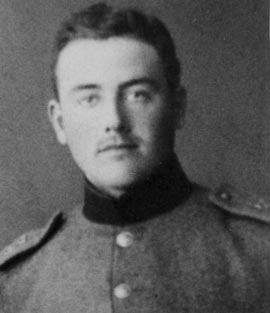
The life of a soldier
Hinne and his fellow-soldiers now belonged to the Fifth Battalion, Third Regiment Field Artillery, Third Division of the Dutch Army. How different life was now. Long marches every day followed by exercises in the gymnasium. He was so stiff each morning that he had trouble getting up from his cot. There was a wooden horse in the gym and the instructors made the men jump over that thing from all directions day after day. After a month or so, guess what, their stiffness disappeared. They were getting used to the drills.
Meals consisted mainly of kidney beans, bean soup and a piece of “kuch,” a kind of bread, some butter and a hunk of cheese. They really needed to supplement their diet, but they didn’t have enough money. Their weekly pay was one guilder and twenty cents.
They were taken to Roosendaal, also in the province of Brabant, home of several “maneges” (riding schools). They were ordered to ride some ordinary farm horses without saddles and reins. The sergeant stood in the centre of the “manege” and would occasionally crack his whip to bring the guys into line. They were not allowed to grab the horses’ manes, but most did anyway in order to stay on top. One poor guy kept falling off his horse and was sent home. Hinne thought, what if I let myself fall, maybe they will send me back to Terschelling! But a Terschellinger doesn’t fall of his horse, not after years and years of riding on the beaches and through the dunes on the island!
Because Hinne came from one of the North Sea islands, he was not allowed to go on a 24-hour leave like many of the others. For him it was a once-per-month leave. He’d travel by train from Breda on a Friday, and sleep that evening in Hotel “De Eilander” in Harlingen. Early next morning he’d take the boat to Terschelling. On Monday he had to travel back to Breda.
The washrooms and “toilets” in the barracks left much to be desired. Hinne wrote: “If you wanted to move your bowels you ended up sitting beside each other in the open. What was communally donated ended up in a manure gutter, just like in the cow stall at home. Once in a while, there would be a kind of flood...”.
In the morning, after reveille was sounded, their first task was to brush down the horses, then to the washrooms, then to breakfast.
Soon they were given saddles, spurs on their boots and reins in their hands. They had advanced quite a bit. Next they were given theoretical instruction in the use of heavy guns and the art of dismantling and cleaning weapons. The infantry were using rifles. Not so with the cavalry. Hinne and his buddies had to do with pistols.

Visit from Queen Wilhelmina
A little while later the exercises with the heavy guns began. Each assembly required a span of four horses. Hinne rode the lead horse, handling the reins of the horse beside him as well.
One day he had to report for inspection. Something strange happened next! An officer called his name and Hinne replied : “Present!” Suddenly, the lieutenant stood still. “De Jong,” he said, looking at Hinne with a puzzled expression on his face. “I’m awfully sorry,” he said, “but we just buried a de Jong yesterday and I’m thinking, how is it possible that he stands here today?” Hinne was dumbfounded. Obviously, there were more de Jongs in the Army!
He vividly remembered the day Queen Wilhelmina came to visit Breda. Everyone was feverishly busy making the place look spick-and-span. Hinne observed how strange the officers behaved, becoming more nervous by the minute. When the Queen arrived, Captain van Andel couldn’t stand still for even a minute. The Queen observed it all, including the nervous characters referred to as officers. But, being Queen Wilhelmina, she put them all at ease with a few words.
Public profession of faith on Terschelling
When he was twenty years of age, during the winter of 1916-1917, Hinne went to profession of faith classes in Breda. The idea was that during the 1917 spring he would make public profession of faith in the “Westerkerk,” the Reformed Church in West-Terschelling.
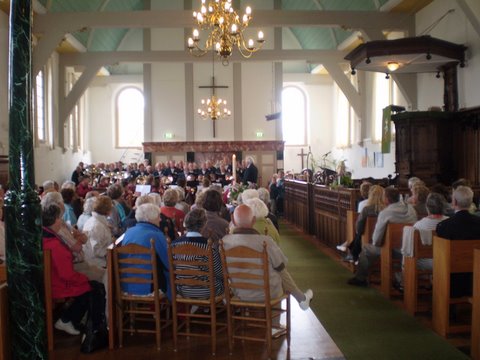
Sense and Corrie attended a service in the "Westerkerk," West Terschelling, during May 2008. This is the church where Hinne did public profession of his faith.
It wasn’t easy to arrange the necessary leave, but Hinne received fine support from Sergeant van der Meulen, who hailed from Leeuwarden. So, one Friday, he left Breda and arrived the next day on Terschelling. From the harbour, Hinne went straight to “Dominee” Vossers, who, together with Elder Willem Wortel, would examine him. They were impressed with Hinne’s answers and the next day, Sunday, he joined the others to make public profession of their faith in Christ Jesus, our Lord and Saviour.
At that time, Hinne was courting a “famke” (lass) from Terschelling. Her name was Annie de Jong (no kin) and she stood beside Hinne in the front of the church. The whole class was requested to stand and sing a hymn by themselves. They sang: “Lord, where to then? To You alone! I will never disown you. Your only Son has for us again unlocked the way to Your throne.” Hinne held the song sheet in front of Annie and he nearly dropped it because his hands shook so much. He wasn’t used to singing alone in a church filled to the rafters.
Sick leave and a hazardous boat trip
Hinne came down with a mysterious illness after serving in Breda for some time. The Army doctors there couldn’t figure out what was wrong with him. He was, finally, allowed to go to Terschelling on sick leave. It took some time, but Dr. Bosch, stationed with the Navy on the island, correctly diagnosed what was wrong with Hinne. He had pleurisy.

The M.S. Friesland in Harlingen harbor about to leave for Terschelling.
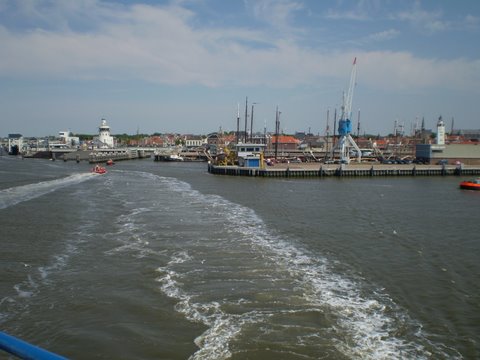
Sense and Corrie took the modern ferry 'Friesland' during May 2008, leaving Harlingen harbor (above) and arriving at Terschelling (below).
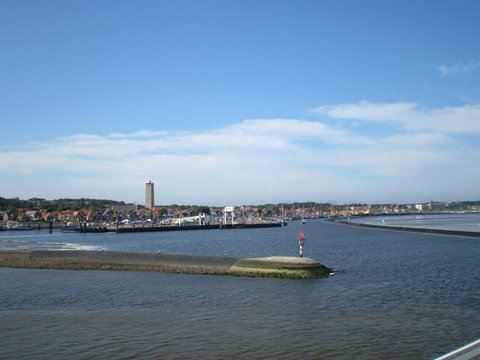
Something had happened, however, on the boat trip from Harlingen to West-Terschelling. Hinne had left Breda, as usual, on a Friday, slept in Harlingen, and boarded the 7 a.m. mailboat to the island. It was winter and the sea was full of ice. There was open water in the harbour and the captain decided to leave. Once in the open, however, the ship got stuck in the ice. Hinne and the others were warmly ensconced below deck. After a while they went on top to have a look. It was bitterly cold. The boat was going backwards and then tried full speed ahead to ram the ice. They succeeded to go forward like this for a bit, but they then noticed they were drifting off course trapped inside a field of ice. This was serious, since they might drift into shallow waters or hit a sandbank.
Suddenly, the drifting stopped. A buoy got dragged right under the boat and its chain worked itself into the screw. Hinne wrote: “ This was dangerous. There was a possibility that the drift ice would push the boat right under the thick ice.”
On board was a veteran pilot from the island of Vlieland who called everyone to meet him on deck. He said: “People, we now have to fight for our lives. Please listen. This is what I would like you to do.” He went on and explained that it was important to keep rocking the boat all the time. Every able person needed to go on the promenade deck and walk from one side to the other. Also, everything that was heavy had to be dragged to the bow of the ship and so try to raise the stern (aft section). This was done and, lo and behold, the ship’s screw became visible. Someone, with enormous courage, went overboard and wrestled the chain free from the screw. Hinne didn’t remember who that was, but, he wrote, that man braved the ice-cold water and got the job done.
The captain decided to go back to Harlingen harbour. But he couldn’t turn the ship around. So, they kept going and the walking from side to side was resumed. After a long time of ramming the ice they made it to open water. Everyone went below deck to get warm and drink something nice and hot. Wouldn’t you know it, it then started to snow and visibility dropped to near zero. They struggled on, however, and eventually made it to port on Terschelling. They had left Harlingen at 7 a.m., arriving on Terschelling at 5 p.m. A ten-hour trip, which normally takes two hours.
Consequences of a difficult crossing
Hinne wrote that the afore-mentioned pilot from Vlieland, who so bravely took over command of the ship, became seriously ill following this trip. He died six months later.
Hinne’s own condition deteriorated also. After a month-long stay on the island, he dreamt one night that they were piling more and more artillery shells on his chest. He woke up in a sweat with severe chest pains. The Navy doctor was summoned and after a thorough examination ordered him to stay in bed. He visited Hinne each day thereafter and ten days later he declared
that Hinne suffered from pleurisy. They eventually inserted a hollow, glass tube in his back - close to his kidneys - to drain the fluid away.
During his illness, Hinne’s brothers and sisters visited often. Sometimes they came together when he was particularly weak. Annie de Jong, his girlfriend came to his bedside and so did his uncles and aunts. Hinne gleefully wrote about one inimitable aunt: “Tante Anna always said that if I needed to fart to let them blow, Hinne, let them blow, jongen, and don’t fight them!” Hinne fully agreed with that, knowing all that needed to be known about flatulence....
He was convalescing in the “mooie kamer” (front room) of the farm house on the Willem Barentszkade. From there he had a splendid view of the goings- on in the harbour. His mother and sister Griet looked after him. The doctor continued to drop by regularly and, one day, several months later, that man noticed that the liquid coming from the tube was no longer clear. It was blood and Hinne was nearly unconscious! In a flash he had the tube out and ordered that Hinne be given a shot or two of cognac (brandy). Hinne wrote later that the doctor considered this the turning point. And, indeed, Hinne slowly but surely improved after that eventful day. His period of convalescence on Terschelling continued and he was spoiled by those who nursed (and loved) him. Once in a while, he and his friends were allowed to go trekking through the dunes. This was also the time that the Spanish flu claimed many victims in the Netherlands, including Terschelling. Since Hinne was susceptible, due to his weak condition, he had to be extra careful. Fortunately, the flu passed him by.
Back to Army life
When Dr. Bosch figured Hinne was strong enough, he went back to his barracks in Breda. For the time being, he was excused from the heavy tasks. Instead, they asked Hinne to deliver fresh meat to the homes of the officers living in Breda. He used a bike for this which was outfitted with a “korf,” i.e. basket, in front of him.
He discovered that for every day he had been sick on Terschelling he was entitled to “manege-money.” When he asked the administrator about this the man refused to pay. So, Hinne went to the Captain and with that man’s help he got his money: eighty-four guilders - in those days a considerable sum.
Then his regiment was transferred to Walcheren in Zeeland, the province next to Brabant.
They were ordered to haul the heavy guns to the big dike close to Domburg. The story went that the English were planning to blow up that dike, so that Walcheren would be inundated. Hinne thought it was all hogwash.
Laster, Hinne was ordered to a border-patrol unit near Breskens, which meant crossing the Westerschelde. Hinne then recalled what Dr. Bosch had told him: do not get cold again and do not get your feet wet. So, Hinne refused. His officers insisted, but he refused. The Army doctor checked him out and advised that Hinne appear before a committee of doctors in Middelburg. To make a long story short: the committee gave Hinne a three-month leave and the next day he went back to Terschelling!
On November 18, 1918, the Armed Forces of the Netherlands demobilized. The Great War was over. Hinne travelled to Breda to return his military uniform, etc. So, after his sick leave, Hinne never did go back to active service in the Army.
Hinne and his girlfriends
While on leave on Terschelling, his relationship with Annie de Jong came to an end. But to say goodbye was easier said than done. Hinne’s aunt Tante Anna was extremely upset. During a visit to her home, she picked up her chair, planted it in front of the door, sat on it, and said to Hinne she wouldn’t let him out again. Later, Hinne met Annie’s mother who refused to shake hands with him. Jilles Roos, one of Hinne’s friends, would have liked to go out with Annie, but she declined. Hinne wrote: “She did eventually marry Albert Kaale, the third member of the three musketeers!”
Annie’s father, Hermanus de Jong, was the man who had won so many races with the “Amelander” (see Chapter 8). During WW II, Hermanus was hit by a German vehicle and had to be hospitalized in Harlingen. There Hinne visited him one day. Hermanus was visibly moved to see Hinne and started to weep. He told Hinne that neither his wife nor any kids visited him much anymore. Hinne felt deeply sorry for him. Hermanus never recovered from the injuries sustained. He died in Harlingen.
Hinne had his eye on another Terschellinger “famke.” Her name was Aafje Wortel, a sister to Cor - his brother Jaap’s wife. Trijntje, Hinne’s sister, told him one day that Aafje didn’t want to go with Hinne because “he was not of her standing.” And yet, Hinne and Aafje had been on the same choir, went “opperied” together, and went out on sleigh rides in the winter. Aafje later married a student of the Nautical School, who later made it to the rank of captain. Hinne wrote wryly: “She probably figured: better a captain than just a farmer.”
Making plans for the future
Prior to leaving the Army, discussions took place on Terschelling what Hinne should do once he was discharged. Consensus was that Hinne would have to seek a career on the mainland. The farm in "'t Landt" was simply not big enough to sustain two families. Already then a number of boys from the island had gone to the special school of the “Nederlandse Heidemaatschappij” (NHM) in Arnhem. Hinne enrolled, too, and successfully passed his entrance exam. The classes started October 1, 1919.
The “West Aleta” story
We now jump forward to the time Hinne came home on vacation during February, 1920. What follows in Hinne’s memoirs is another typical story related to beach combing on Terschelling.
Still on the mainland, Hinne was told that the American steamship “West Aleta” had broken up on the shores of Terschelling. This ship left San Francisco during January, 1920, carrying 18,000 barrels of California wine. Its destination was Bremen/Hamburg, Germany. The ship came to grief during a heavy storm off the coast of Terschelling. The rescue boat “Brandaris” was called upon to help and its crew managed to save 45 lives. The next day, the “West Aleta” broke in half and sank. But thousands of barrels of wine started drifting away, landing on many beaches. It was a hey day for the beachcombers!
(Comment: The abundance of wine found everywhere after the sinking of the “West Aleta” has been attributed to starting up several businesses on the island and the mainland. A certain Jan Kooyman from Baaiduinen on Terschelling, together with a man called Stienstra from Harlingen, started a wine/liqueur distribution business on Terschelling during the early 1920s. Today (2008) my cousin Annie -daughter of Oom Herman - is married to Roelof Kooyman, whose children still run this business on the island! Among all the disasters involving ships around Terschelling, the story of the sinking of the “West Aleta” is the most famous. - sdj)
Hinne arrived on one of those days with the 4 p.m. boat and was told that his Dad and brothers, Herman and Tjebbe, had slaved away, hiding quite a few of those barrels in the sand. They had gone home to rest and sleep, but soon they were off again, taking Hinne with them. Off they went throught the dunes to “Paal 6,” then left to “Paal 3.” That’s were the barrels were hidden. With great difficulty they managed to get three barrels on the wagon and then proceeded west. Some of barrels they found there were already open. They filled the bottles they found and kept sipping the stuff on the way, getting slightly intoxicated. Hinne found some sardines and it helped them to keep sober.
Early in the evening they approached the village of West-Terschelling, always aiming for the “Brandaris” tower. In the twilight they came to a spot called “Toerenmol,” a well-known mud hole. Hinne was driving the horses. His head was far from clear and he would have driven straight into this dangerous hole had it not been for Tjebbe who, just in time, grabbed the reins and led the horses to safety.
Meanwhile, brother Jaap had remained behind to guard the other barrels. But Jaap was a baker and had to make bread in the early morning. Hinne had agreed to replace him. At home, he had a meal, rested a bit, and left again, arriving at “Paal 3" at 10 p.m. It was miserable weather, it was cold, the wind was howling and the sea was roaring. Eventually, Hinne said: “I’m nuts to stay here, I’m going home!”
He struggled for a long time through the dunes but made it back to the village. But his brother Herman noticed him going to bed and gave it to him with both barrels. “How dare you leave those valuable barrels unguarded! Go back, and go back, now!” Dutifully, Hinne slogged back all the way to “Paal 3.” So he sat there till the morning when they came with the wagon to pick up the rest of the barrels of wine. Hinne wrote: “The family de Jong - and many other families on the island - made good money with this wine business. That’s how my parents were able to pay for my room-and-board expenses during my last months in Arnhem.”
Hinne’s Dad and Mom pass away
Opa Cornelis Harmens de Jong, Hinne’s Dad, died in 1929 at the age of 72. He had suffered a stroke three weeks earlier while weeding his garden at Halfweg. Hinne wrote: “I worked with him until my twentieth year. He always suffered much from stomach ailments. Leaving early in the morning to milk the cows, he’d lay down on the wagon writhing in pain and we had not even passed the ‘Dellewal.’ After a bad spell of vomiting he’d begin to feel better and soon he was able to do his work again. Some years later he underwent an operation and then these cramps disappeared.”
Oma Trijntje de Jong (nee Stobbe) died at age 70 in the year 1930. According to Hinne, she so deeply grieved the loss of Opa that she lost the will to live. She died at the newly-built farm in ‘t Land where, later, Oom Tjebbe and Tante Trijn, raised their family. Hinne’s Dad had participated in the planning for that new farm house and the barn. He had so much looked forward to living there. But the Lord had other plans.
Hinne wrote: “All the money I earned while working on the farm went back into the business. When I attended the Heidemaatschappij School I had no money to pay for room-and-board. So, once in a while, my parents would sell a cow to generate some cash.”
(P.S. Opa and Oma de Jong were buried in the old cemetery lying at the foot of the “Brandaris,” in the middle of town. Years ago, Corrie and I found their graves as well as those of Hinne’s uncles ,aunts and some of his siblings. One could write many books about the lives of all these people who found their last resting places in the village that was so dear to them. The cemetery is worth a visit! - sdj)
[an error occurred while processing this directive]